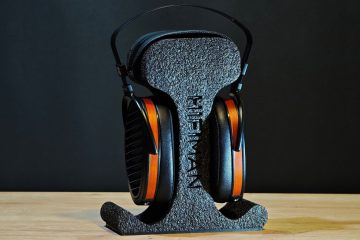Introduction
Sennheiser’s IE600, released a year after the IE900, was very well received despite being a cheaper version. Some people think it’s a great version, optimized in the light of feedback, while others think the IE900 is clearly better. IE600 was available with a price tag of $800, these days it’s $599 on the official site. I obtained the product myself to write an independent review, and I did about 100 hours of listening before the review.

Design & Build
Package
Sennheiser IE600 has similar box contents to the IE900, and this is exactly what comes out of the box:
- IE 600 In-Ear Headphones
- Unbalanced para-aramid reinforced cable with 3.5mm connector
- Balanced para-aramid reinforced cable with 4.4mm connector
- 3 pairs of silicone ear adapters (S, M, L)
- 3 pairs of foam ear adapters (S, M, L)
- Premium carry case with metal serial no. plate
- Cable clip, Cleaning tool & Cleaning cloth
- Presentation box with signed customer certificate and user manuals

The IE600’s Shells, Tips, Cables
Sennheiser ie600 comes with those terrible tips, as does the IE900. Since it’s impossible to use them, I’m writing this entire review using Pentaconn Coreir tips. I explained this in detail in the package thread of the IE900 review.
The IE600 zircon coating has highly durable shells. I find this great considering my IE900 is covered in scratches. Fit and isolation are average. Unlike the IE900, the IE600 doesn’t have a 2.5mm cable, anyway who uses 2.5mm in this era 🙂 These cables are exactly the same as the IE900, but are quite enough. Except they are a bit microphonics.

Synergy
The Sennhesier IE600 is an iem that can both glow easily and fade into the dark easily. This sensitivity is both good and bad. Good because it gives flexibility to shape the sound. Bad because it’s not satisfied with even good sources, it demands the best source device. The power requirement is actually average for an iem, but it matches better with more powerful devices (daps).
IE600 With Hiby FC6
The slightly V-shaped and balanced sound of the IE600 gains a lot of body with the warm sound of the Hiby FC6. The resulting sound is thick and natural but also a little dark. I think the FC6 pairs much better with the IE900, while the ie600 lacks a bit of excitement. Still, this pairing has incredible note weight and good imaging. However, due to the analog-like timbre of the FC6 and the nature of the R2R dac, you have to turn up the volume for the full technical potential. This has a bit to do with IE600, because it’s a very sensitive iem. Strangely, the ie900 produced by far more detail with the FC6 at nominal volume. Still, this pairing has an effective dynamics. My score for this pairing is 7.9/10. I would like to point out that the FC6 is better matched to brighter Far Eastern iems.

IE600 With iBasso DX180
More brilliance in a more relaxed tone with the iBasso DX180. There is a more analytical presentation than the previous pairing. It plays more open and more relaxed, but without the dense sub-bass texture of the FC6. There are two reasons why I get a more technical sound, the first is tonality. The tonality part is perceptual, it’s called analytical rather than technical. The second is purely technical, power. Sennheiser IE600 is a sensitive iem but the dynamic driver loves power. The resulting sound is immersive, almost between V shape and U shape. It’s brighter and cleaner in comparison but also more body-less. In my listening I found the ie600 to be better matched to the 3.5mm output than the 4.4mm output. My score for this match is 8.3/10.

Sound
When reading this section, keep in mind that I am writing using Pentaconn Coreir tips.
Tonality
A V-shape faithful to the natural sound. I say this because although the upper and lower frequencies are at the forefront, the amount of extension is controlled and the upper treble is just below the threshold of sharpness. The mids are not as reserved as the IE900. In fact, the sense of space I mentioned in the ie900 is also present in the ie600, but to a much lesser extent. In fact, it is often overpowered by the tonal effect of the source device.
Bass
The lower frequencies follow the line of the ie series. Crisp, well separated and deep. Listening to Haggard’s A Midnight Gathering, the drums sound very realistic. The sub bass is more dominant than the mid bass and a bit too humming in electronic genres, too much for me but enthusiasts will love it.
Mid
The mid-range is quite nice this time 🙂 As strange as it is to praise the mids of a V-shape iem, the IE600 deserves it. Transparent, consistent and accurate. The upper registers of the guitar notes are a bit high but still have a good timbre. It’s especially good on acoustic tracks. The IE600 performed especially well on the My Songs Deluxe version of Sting’s Shape Of My Heart, which you all know. In Ie600, where female vocals are a bit more prominent, it is also very enjoyable to listen to solo violin. With these headphones, I listened to Caprice No.24 played by David Garrett with great pleasure. Unfortunately, I can’t say the same for the multi-instrumental pieces with female vocals. Although natural, there are some pieces where they are unbalanced. When the female vocalist’s voice gets shriller, the ie600’s volume rises dramatically out of proportion.

Treble
Sennheiser IE600’s bright highs are reasonable except that they rise too quickly at the ends of female vocals. Yes, they are a bit bright, but that doesn’t change the fact that it responds well to the source. There is a fast rise in the transition from mids to treble and this causes spikes in normal listening. This is especially noticeable on female vocals and guitar. I think the treble is not bad at all for the price point. Considering that IEMs with Est drivers can now be bought for around 500 dollars, the single-dynamic IE600 is in a very good position with what it gives. The cymbals are clear and the amount of extension is good. Air frequencies are natural and there is no rustling. I find it a bit too loud when going from the low treble to the mid treble.
Technique
The IE600 is a headphone that performs to its full potential with high-end sources. I realized this very clearly when listening with the Astell Kern SE300. You asking why I didn’t include it in the Synergy section of the review. I think I haven’t spent enough time with the SE300 yet to include it in the reviews. Read this section knowing that I will be basing this as much as possible on what I hear from other sources.
Sennheiser IE600 has quite high resolution and good separation. The imaging ability is reminiscent of the IE900. The layering is great and the presentation is airy. It’s hard to find anything to judge technically, especially considering the current price. A little more texture and control in the lower frequencies would have been nice. The stage of the IE600 is a Sennheiser classic, the positioning is successful. The stage is wide enough, maybe a little deeper. Treble resolution is high but control and texture are poor compared to high-ends with est drivers.

Comparisons
Sennhesier IE600 ($599) vs Dita Project M ($325)
Both are very good iems, but Project M is almost half the price of the IE600. Both are V shape. In the lower frequencies the IE600 has both better texture and better extension. Sennheiser IE600 is also clearly bassier. In the midrange they are quite close, but Dita Project M is more balanced. The IE600 is more detailed on this area. When we come treble, the ie600’s lower highs are brighter while the Project M’s air frequencies are more prominent. Both produce good detail in this area, but the Project M is more consistent and shows better extension. Project M is more adept at capturing fast highs. In terms of stage and imaging, they are about equal. Technically they have similar resolution. In general, Project M has a more balanced sound profile except for air frequencies.
Project M is a harder to drive iem, IE600 is more sensitive. This introduces a lot of source effects. In summary, for sources relatively less than $500, the situation seems to be equal and sometimes Project M is even better. But on high-end sources (in my experience with the Astell Kern Se300) the IE600 wins in every area. It both technically resolves the sound better and offers a more relaxed and separated sound. So if you’re someone who listens to music with a dongle, Dita Project M is a much better choice. But with a dap that costs more than 1000 dollars, I think the IE600 sounds better.

Sennheiser IE600 ($599) vs IE900 ($1199)
The IE900 sounds a bit wider and more open. The IE600 is a little warmer and noticeably stronger in the lower frequencies. My preference in this regard would be the IE900 by far because I find the IE600 too humming. The bass is more intense on the IE600 but has better extension and better control on the Sennheiser IE900. When we get to the mids, it’s a bit different. Although the IE900 has more microdetail reproduction and the V character of the IE600, I found the mids of the IE600 more listenable, especially on progressive metal tracks. This is partly because of the IE900’s recessive mids and partly because the IE600 is very balanced in the midrange except for female vocals. As for treble, while the ie600 is good for the price, it is overshadowed by the superior treble performance of the IE900.
Technical Comparison
On the technical side, the IE900 has higher resolution and better imaging. In terms of stage they are similar, but the IE900 plays a bit further away. They are close in positioning and separation, and the IE900 is better at layering. Both are quite detailed, with the IE900 adding a bit more texture in the nuances. Apart from that, the IE600 is a bit more bodied and the IE900 a bit more analytical. In fact, the technical difference becomes apparent as you move towards the ends of the spectrum. Personally, I find the IE900 much better in terms of emotion transfer and naturalness. At this point, the two-fold price difference is a head-scratcher. I think the choice should be made by considering the source synergy and expectations.

Last Words
The Sennheiser IE600 is an iem with a current price of $599 and the capabilities to remain competitive today. However, I don’t recommend this iem especially for dongle users, as this sensitive single-dynamic only works well when paired with a very good source. For the dongle class, hybrid models may make more sense. But if you have a $1000+ dap, I strongly recommend the IE600, great sound for a $600 iem!











